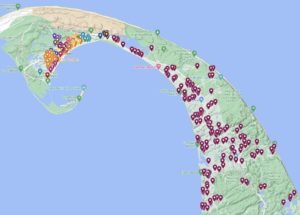TRURO — All four Outer Cape towns are focused on wastewater management, and for good reason: our drinking water comes from the same narrow sandbar that we live on, and that our wastewater, by necessity, is pumped into. The lenses of rainwater that are suspended in the sand may be invisible, but they are constantly in the thoughts of health officials and a major constraint on how property can be used.
When it comes to public discussion of wastewater, there is a clear pattern: nonprofessionals are eager to talk about new development, especially affordable housing. The professionals in the field, however, want to talk about cesspools.
At a Truro Board of Health meeting in December 2020, vice chair Jason Silva, a licensed septic engineer, gave an impassioned monologue about cesspools.
“A Title 5 septic system emits 25 to 40 milligrams of nitrates per liter,” said Silva. “A cesspool puts out anywhere from 20 to 200 mg/L — which is shocking. You have people on their own land, their own house, pumping out 120 mg/L. They’re not upgrading their system, they’re not reaching in their pocket to pull out $30,000 because it’s the right thing to do.
“I don’t see people routinely pumping out their system, either,” Silva added. “It’s a $300 fix to make a bad situation a little better, and that’s not even being acted on.”
Nitrates are harmful to aquatic life in both fresh and salt water and can be dangerous for human health as well. The EPA drinking water standard for nitrates in public water supplies is 10 mg/L.
Six months later, the Truro Board of Health became the first on the Outer Cape to require the removal of all cesspools — by the last day of 2023.
Provincetown, meanwhile, is working up a $75 million proposal to sewer the entire town, which would mean the end of cesspools in 2030.
Exactly how many cesspools there are, however, hasn’t been known until recently in Truro or Provincetown, and still isn’t known for certain in Wellfleet and Eastham. The Independent spoke with health agents in all four towns to find out exactly what is known about the quantity and location of cesspools.

When Truro created its new regulations last May, officials estimated there were just under 200 cesspools in town. In January 2022, Truro provided the Independent with a list of 168 properties with known cesspools. They are widely distributed, including along the Pamet River, Little Pamet River, and Shore Road.
Since then, 23 cesspools have been removed, and another 33 properties are in the process of upgrading their systems, Health Agent Emily Beebe said last week. More than half of the cesspool owners have contacted the town “to discuss how to come into compliance,” she said.
“We definitely feel we’re making progress, and we’re optimistic,” Beebe added.
Provincetown’s health department presented a detailed “Onsite Wastewater Status Report” to the select board in September 2021, including for the first time a cesspool total: 153. More than half are in areas of town that are at least partly sewered, including the Shank Painter area and the East End.
In January, the town gave the Independent a complete list of addresses with cesspools in response to a records request. That list showed 131 properties with one cesspool each, and one property with 22 cesspools, for a total of 132 properties and 153 cesspools.
The 22 cesspools were at 39 Ship’s Way, a single parcel that includes 23 residential units in nine buildings. Those houses are all vacant, though, with no active water usage at the property.
Mapping the addresses shows other significant clusters of cesspools, including on Pearl Street, Conwell Street, Howland Street, Cottage Street, and Shank Painter Road.
Other areas have almost none, though, including large parts of the far West End.
Eastham Health Agent Jane Crowley said the town keeps information on all septic systems but does not have a full list of properties that still use cesspools.
If a property owner asks for a building permit, Crowley said, upgrading the septic system is required. Sometimes the Eastham Board of Health requires property owners near fragile watersheds to upgrade to an innovative/alternative (I/A) system, Crowley added.
She said these “very stringent compliance triggers” have resulted in a “reasonable and effective program.”
Wellfleet has 3,148 septic system records for the town’s 3,856 developed lots. According to Health Agent Hillary Greenberg-Lemos, the properties with records are unlikely to have cesspools, and the lots without records certainly could.
“The board of health is very concerned about continued use of cesspools,” Greenberg-Lemos said.
At an April 13 board of health meeting, environmental engineer Anastasia Rudenko proposed two possible sewer districts, the first including private I/A systems at the affordable housing development at 95 Lawrence Road and the existing Harborside Trailer Park and a municipal sewer system for Duck Creek and the Cove.
The second proposed district added municipal systems at Drummer/Blackfish, Wellfleet Harbor, and Loagy Bay. Wellfleet has not yet made a decision on either proposed system, according to Greenberg-Lemos. The construction timeline is also unknown.
At that same meeting, Greenberg-Lemos outlined a draft regulation banning cesspools with a final removal date at the end of 2024, but there are no public hearings scheduled on that proposal, Greenberg-Lemos said.



